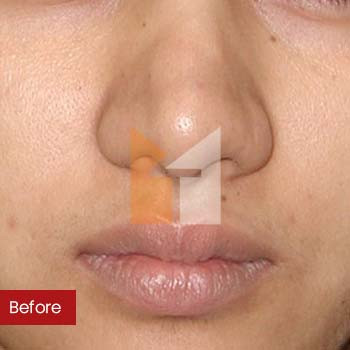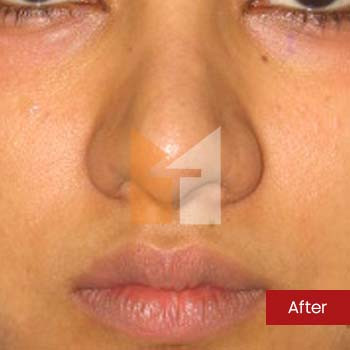Rhinoplasty Surgery in Mumbai, India
Have you always disliked the appearance of your nose due to its shape or size and thought of getting done with it once and for all? Well then, this is the right place to undergo a nose job to provide your nose with a new shape. As one of the most common cosmetic procedures in the world, Rhinoplasty is a surgical procedure that does wonders in restructuring the shape of your nose.
Rhinoplasty surgery can be performed for cosmetic and functional reasons, such as correcting breathing problems or repairing damage from an injury.
Rhinoplasty as a nose plastic surgery has a long history, with evidence of the procedure being performed in ancient Egypt and India. During the process, the surgeon will make incisions inside the nostrils or outside the nose, depending on the type of correction needed. The surgeon will then reshape the nose cartilage and the bone for you to achieve the desired result.
Rhinoplasty surgery can be performed under general anaesthesia or local anaesthesia with sedation, depending on the extent of the surgery. Recovery time for Rhinoplasty surgery can vary, but patients can typically return to routine work within a week or two after the procedure.
Types of Rhinoplasty Surgery in India
Factors to Consider Before Getting a Rhinoplasty Surgery in India
Before undergoing rhinoplasty surgery, there are several factors that you should consider:
Which Types of Nose Imperfections are Treatable through Rhinoplasty Surgery?
Rhinoplasty surgery can address a wide range of nose imperfections, including:
Why Consult a Cosmetic Surgeon Before Undergoing Rhinoplasty Surgery in India
Consulting a cosmetic surgeon before undergoing rhinoplasty is essential for several reasons:
Benefits of Getting Rhinoplasty Surgery in Mumbai
Rhinoplasty Surgery Procedure
One of the most frequently performed cosmetic operations worldwide is rhinoplasty. Despite this paradigm shift, rhinoplasty remains among plastic surgery's most challenging surgical procedures today. Nasal proportions and symmetry, a major facial landmark, are closely related to facial beauty. Even highly skilled surgeons find it difficult to produce consistent results due to technical challenges, various treatments outlined, and other factors.
Technique Used for Rhinoplasty SurgeryPost Surgery: Rhinoplasty in Mumbai
Post-Operative Care: Rhinoplasty Surgery
After rhinoplasty, take your pain meds, soothe your throat, and rest.
Risk & Complications of Rhinoplasty Surgery
After rhinoplasty, take your pain meds, soothe your throat, and rest.
Post-Surgery Care: Rhinoplasty Surgery
What Kind of Postop Medical Care Should One Expect After Rhinoplasty?
Rhinoplasty Cost in Mumbai
The cost of rhinoplasty surgery in Mumbai, India, varies depending on various factors, including the doctor's experience and reputation, and the quality of the facility. However, complexity of the procedure and nature of treatment also plays a significant role determining rhinoplasty cost in Mumbai. Some other factors influencing the rhinoplasty cost in Mumbai include the type of anaesthesia used, the location of the clinic and the type of services provided by the clinic or hospital’s premises.
It's crucial to note that while rhinoplasty cost in Mumbai is an important consideration, it should not be the only factor when choosing a surgeon. It's significant to select a qualified and experienced surgeon with a track record of producing good results, even if their fees are higher. Additionally, it's necessary to ensure that the facility where the procedure will be performed is appropriately accredited and equipped with the technology and staff needed to ensure a safe and successful outcome.
As a preferred cosmetic surgery procedure, Rhinoplasty cost in Mumbai certainly makes it an affordable yet attractive option for patients in need. Thus, it is of utmost important to consider all the factors determining the Rhinoplasty cost in Mumbai and make a well-informed decision that helps with desired outcome.
Why Rhinoplasty Surgery at Dr. Mohan Thomas Aesthetics?
If you're considering Rhinoplasty, we encourage you to take the step by scheduling a call for a consultation with our Dr. Mohan Thomas Aesthetics team. We at Dr. Mohan Thomas Aesthetics understand the importance of feeling confident in your skin and strive to help you achieve your desired appearance.
Our top priority at Dr. Mohan Thomas Aesthetics is your safety and satisfaction. We only use FDA-approved products and the latest techniques to ensure your treatment is safe and effective. Our highly trained and expert staff with years of experience in the field will help you with all the information needed to make an informed decision about your treatment.
With years of experience, we have a proven track record of delivering exceptional results and providing our clients with world-class care. We understand that undergoing plastic surgery can be a big decision, and we're here to make the process as effortless and stress-free as possible. Our experienced team of cosmetic surgeons uses the latest technology and equipment to provide personalized care to each patient, ensuring your unique needs and goals are met.
Please schedule a consultation, and let our professionals help you step toward a more confident, beautiful you. Our experts will assist you in developing a personalized plan tailored to your needs, and we'll be with you throughout your treatment journey.
Be sure to achieve the appearance you've always wanted. Contact us at Dr. Mohan Thomas Aesthetics today, and let us help you enhance your natural beauty.






